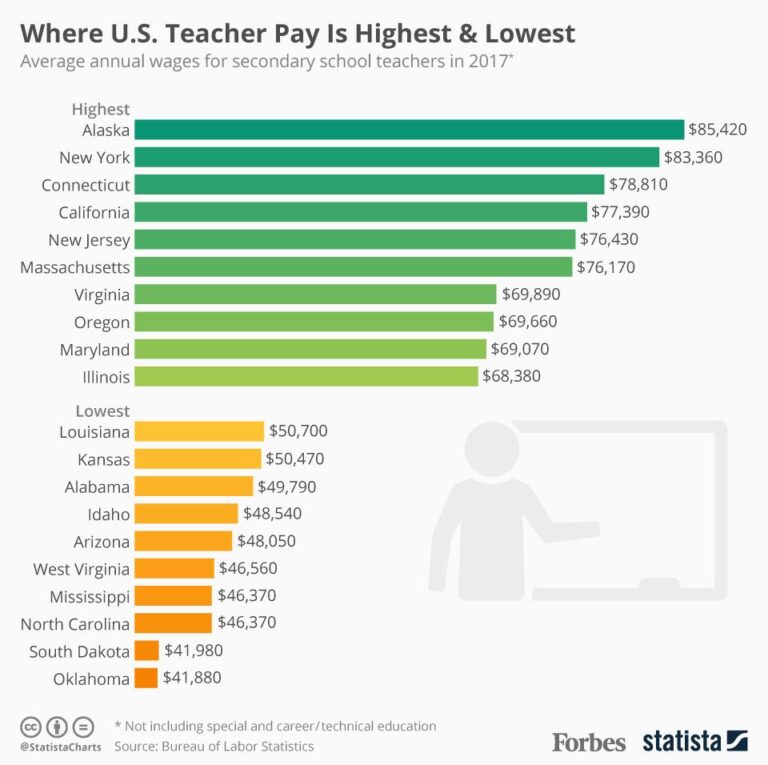While teaching is frequently praised as a vital profession, there’s an ongoing debate about whether educators are compensated fairly for their work. Let’s dive into some of the most common beliefs about teacher pay and separate the facts from the myths.
Myth 1: Teachers Only Work Part-Time, So Their Salaries Are Fair
One of the most persistent myths about teaching is that because teachers get summers off and have shorter workdays, their salaries are proportional to their time spent working. This myth ignores the reality of what teaching entails.
Fact: While it’s true that most teachers have a summer break, this time is often used for planning, attending professional development, or even taking on additional jobs to supplement their income. Moreover, the school day is just the tip of the iceberg. Teachers spend countless hours outside of school preparing lessons, grading, and communicating with parents and students. When you account for these extra hours, the “part-time” myth quickly falls apart.
Myth 2: Teacher Salaries Are Low Everywhere in the U.S.
Another common belief is that teachers everywhere in the U.S. are uniformly underpaid. While it’s true that many teachers struggle financially, there is significant variation in salaries depending on location, experience, and the level of education taught.
Fact: Teacher salaries vary widely across the country. According to the National Education Association (NEA), the average starting salary for teachers in the U.S. is around $41,000, but this can be much higher or lower depending on the state. For instance, states like New York and California typically offer higher salaries, sometimes exceeding $80,000 per year for experienced teachers. In contrast, states like Mississippi and Oklahoma offer significantly lower pay. Additionally, urban districts often pay more than rural ones, and high school teachers generally earn more than those teaching at the elementary level.
Myth 3: Teachers Are Paid for the Full Year
There’s a misconception that teachers’ salaries cover the entire year, including the summer months when they’re not in the classroom.
Fact: Most teachers’ contracts are based on a 9- or 10-month school year. However, some districts offer the option to spread out these payments over 12 months to provide financial stability throughout the year. This doesn’t mean teachers are being paid for the summer months; rather, their annual salary is distributed differently.
Myth 4: Teachers’ Benefits Make Up for Lower Salaries
It’s often argued that while teachers may not earn high salaries, their benefits, such as health insurance and pensions, make up for it.
Fact: While many teachers do receive solid benefits, these benefits are not unique to the profession and often reflect the standard offerings for public sector employees. Furthermore, rising healthcare costs and changes to pension plans mean that these benefits are not as robust as they once were. In many cases, teachers are contributing more to their healthcare and retirement plans than they did in the past, further diminishing their take-home pay.
Myth 5: Teacher Salaries Are Adequate for the Cost of Living
There’s a belief that teacher salaries are aligned with the cost of living in their respective areas.
Fact: In many parts of the country, especially in expensive urban areas, teacher salaries have not kept pace with the rising cost of living. This is particularly challenging in cities where housing prices have skyrocketed. As a result, some teachers are forced to take on second jobs, share housing, or commute long distances to afford to live where they work.
The Bigger Picture
The debate over teacher pay is complex and multifaceted. While some areas of the U.S. offer competitive salaries that reflect the cost of living, many teachers are still struggling to make ends meet. The reality is that teaching is a demanding profession that requires significant time, energy, and emotional investment. Compensation should reflect the critical role teachers play in shaping the future of our society.
Improving teacher pay isn’t just about attracting and retaining talent in the profession; it’s about recognizing and valuing the work that teachers do. As conversations about education reform continue, addressing the disparities and challenges in teacher compensation will be crucial to ensuring that every student in the U.S. has access to high-quality education from teachers who are fairly compensated for their vital work.


